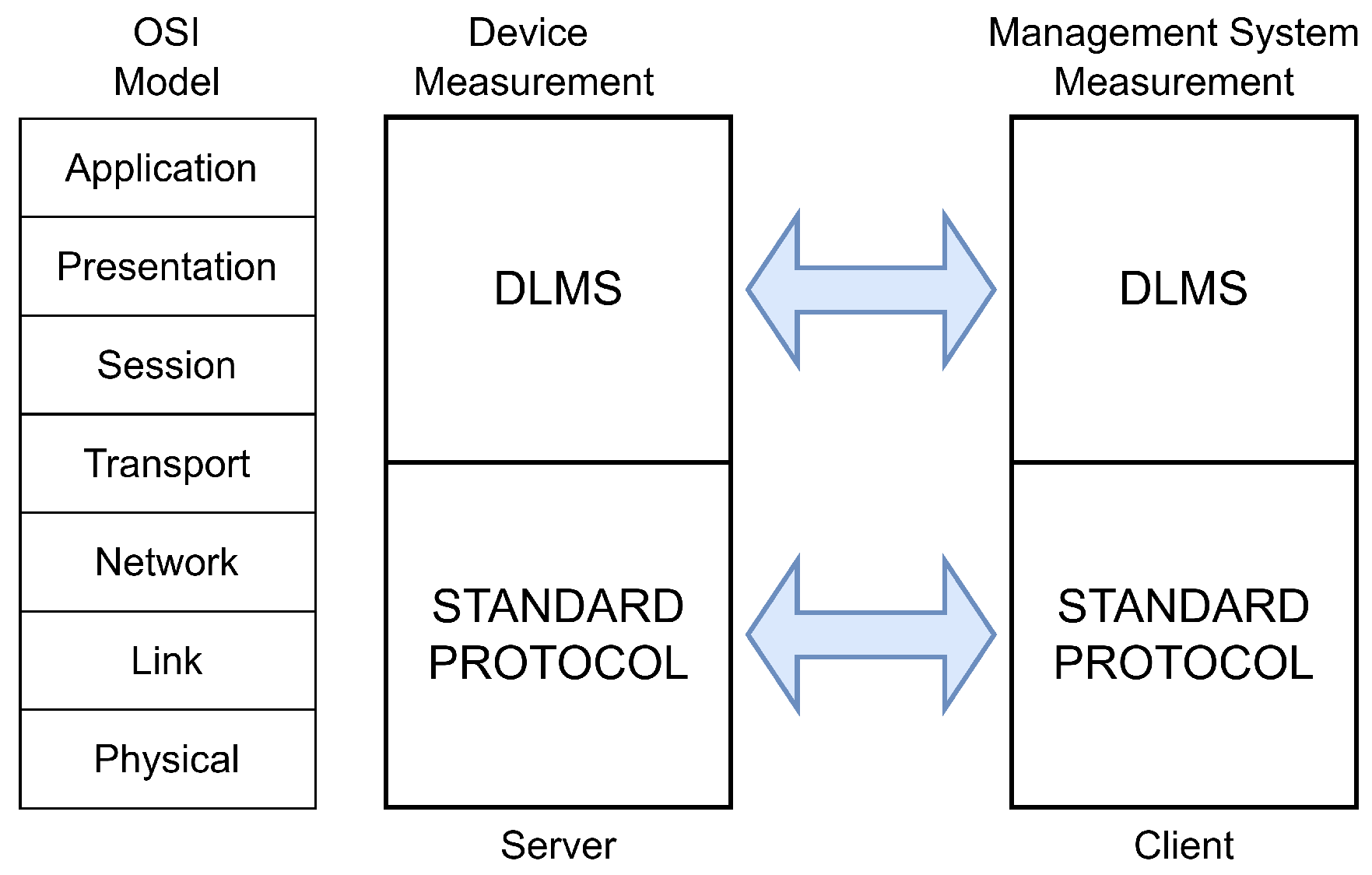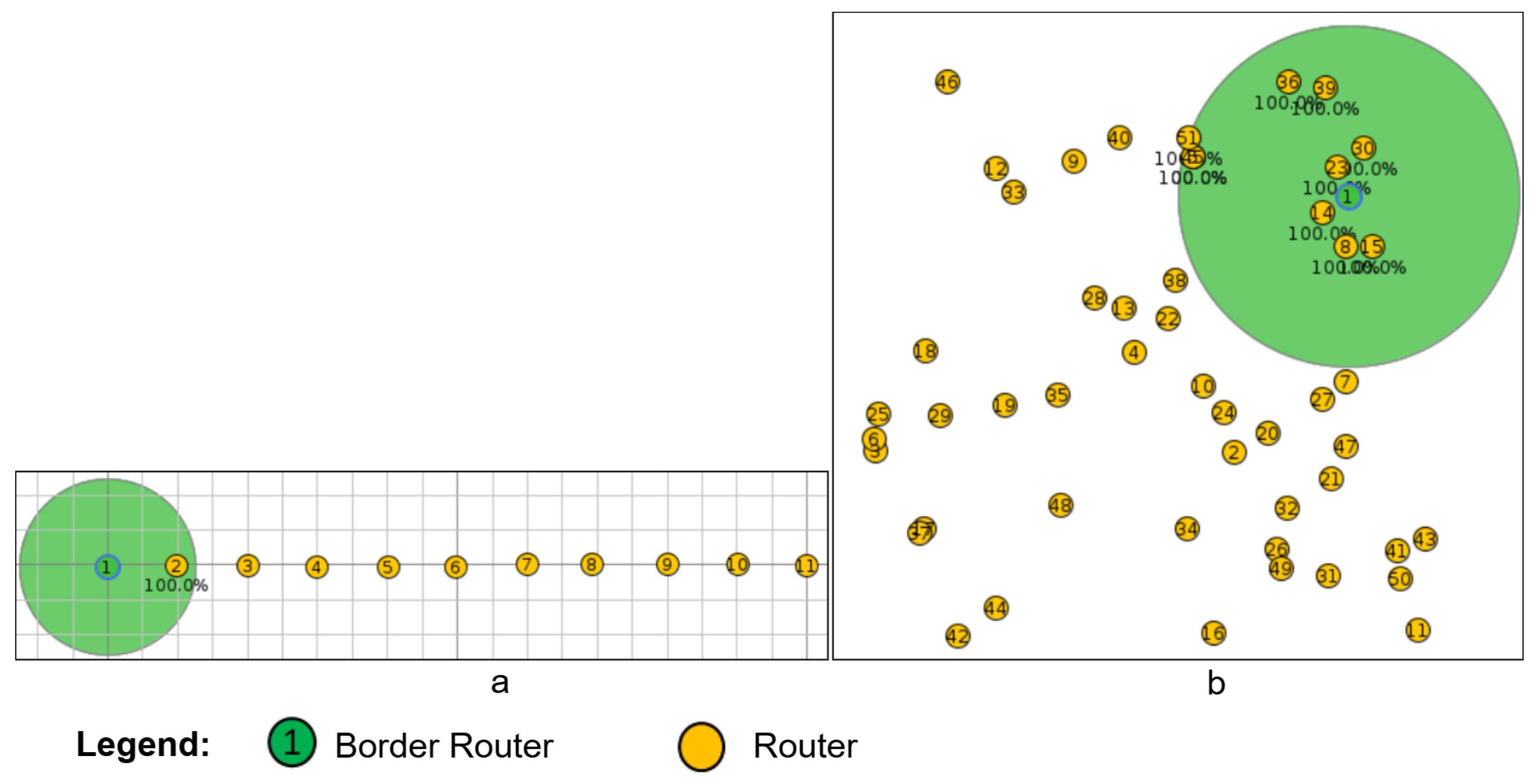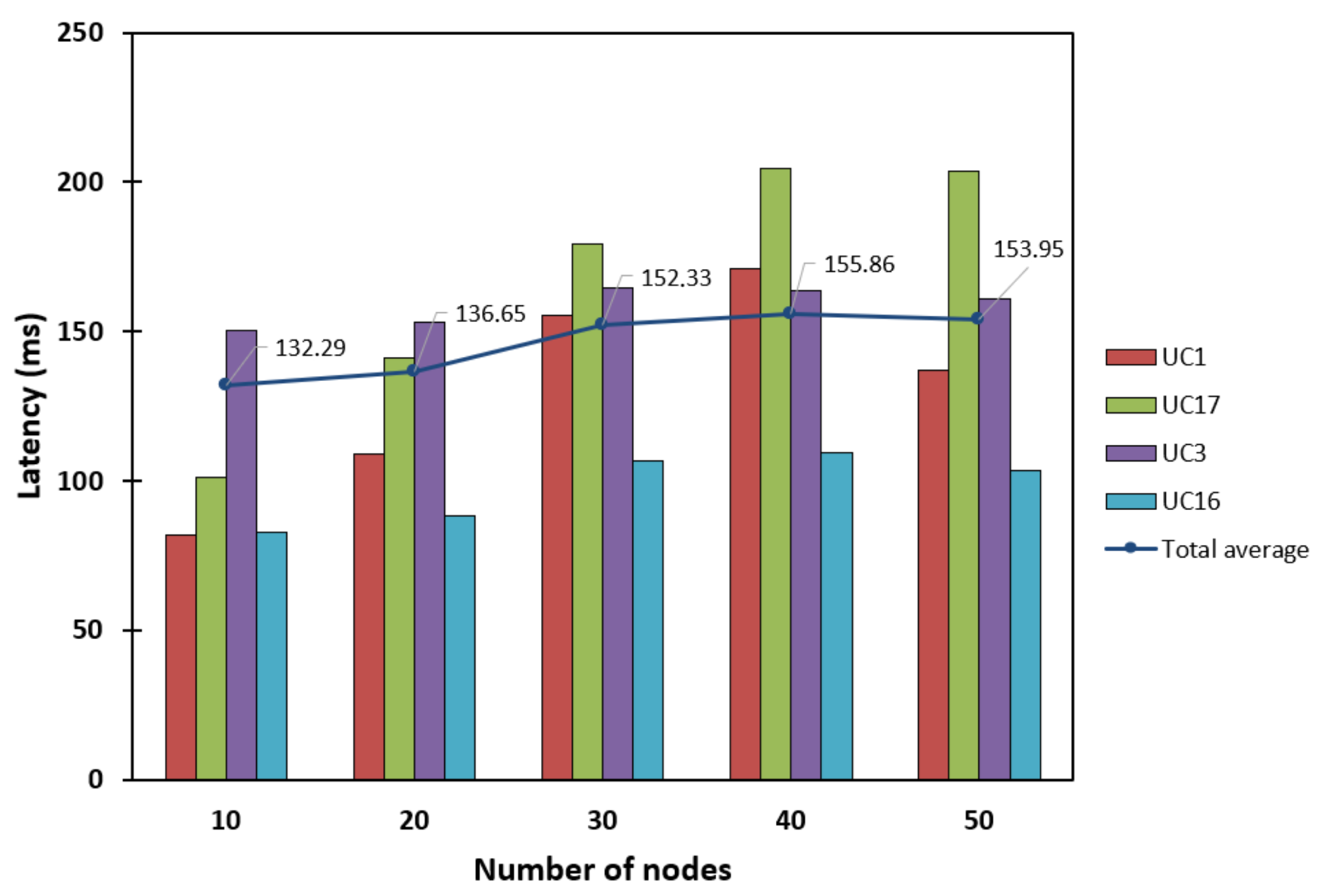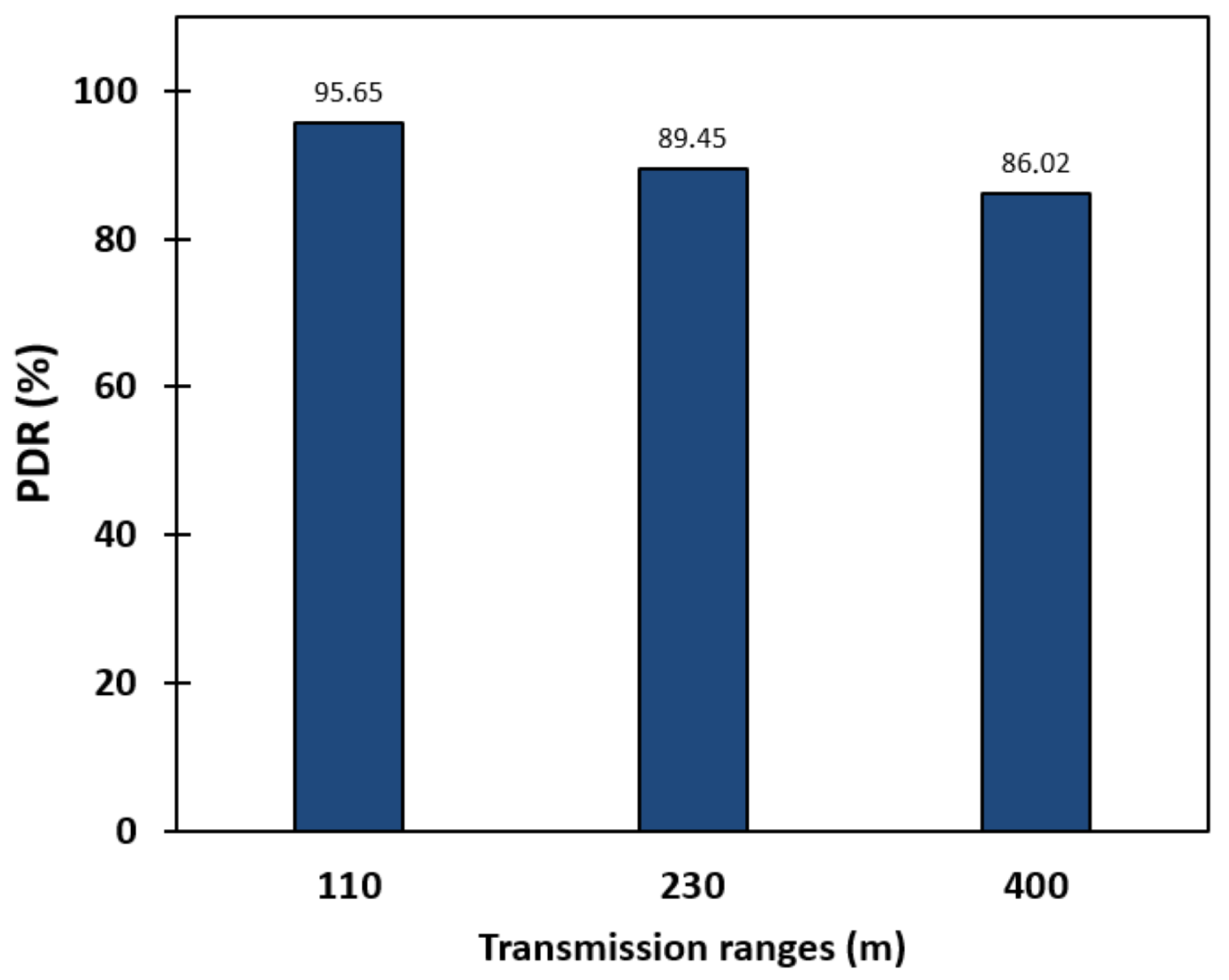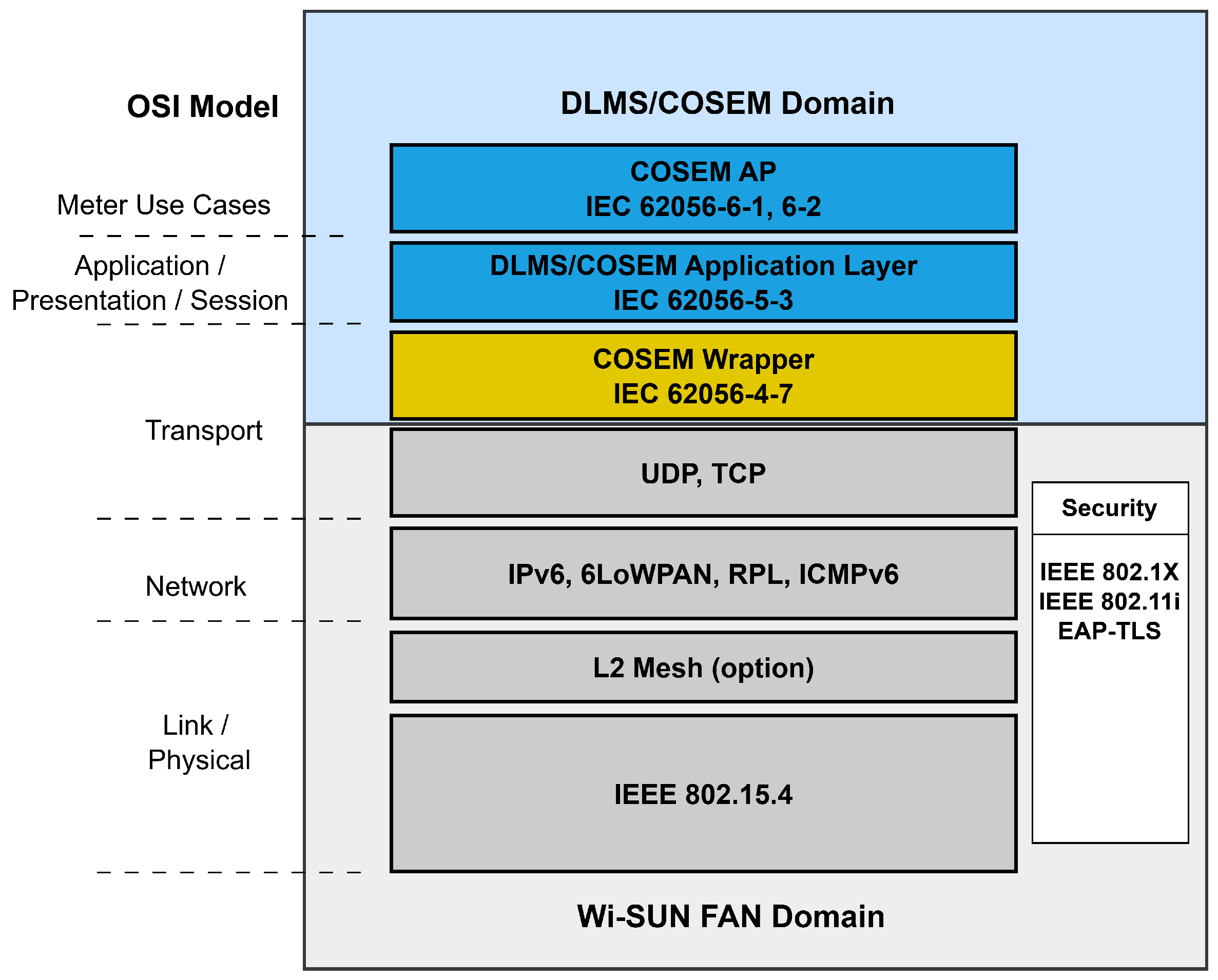1. Introduction
Smart energy meters play a key role in developing efficient and interconnected metering systems. They provide detailed, real-time information to utilities, which enables reporting, analysis, and rapid detection of anomalies and faults in the power distribution network. This reduces service interruptions, minimizes impact, and increases consumer satisfaction by enabling effective monitoring and management of energy consumption. In addition to measuring energy consumption without readers, the meters provide real-time data on power quality and the extent of areas with power outages [
1].
Smart energy meters are essential components of advanced metering infrastructures that encompass communication, supervision, control, and data management. Communication options include wired methods such as fiber, Ethernet, and PLC (Power Line Communication) [
2,
3], as well as wireless approaches such as RF mesh and cellular networks [
4].
Utilities must integrate a variety of information and management systems to improve grid efficiency, enhance cybersecurity, and manage distributed generation. Achieving these objectives requires standardized systems and protocols for effective network data processing [
5].
Device Language Message Specification (DLMS) and the Comprehensive Semantic Model for Energy Management (COSEM) have established themselves as the most widely adopted standards for communication in smart metering systems [
6]. Defined by the DLMS User Association (DLMS UA) and standardized by the International Electrotechnical Commission (IEC) under the IEC 62056 series, the DLMS framework provides a comprehensive object-oriented model that ensures interoperability, security, and scalability in energy metering systems [
7].
DLMS defines an application-layer protocol that enables the exchange of metering information through a set of COSEM interface classes, OBIS (Object Identification System) identification codes, and communication profiles that associate the protocol with specific lower-layer technologies [
8]. This flexibility allows DLMS to operate over a wide range of physical and data link standards, such as Ethernet and IEEE 802.15.4-based wireless technologies. However, as metering infrastructures evolve toward large-scale outdoor deployments with multi-hop connectivity and mesh topologies, new communication standards are required to ensure robust and scalable performance in heterogeneous environments [
2].
In this context, the Wi-SUN FAN (Wireless Smart Ubiquitous Network Field Area Network) standard has emerged as a promising solution for smart metering and smart city applications [
9,
10]. Based on IEEE 802.15.4 [
11], 6LoWPAN, and RPL (Routing Protocol for Low-Power and Lossy Networks) [
12], Wi-SUN FAN supports IPv6-based mesh networks, frequency hopping, and multi-hop routing. Its design allows for the deployment of nodes at both small-scale and large-scale [
9], while maintaining low latency and energy efficiency, making it a suitable choice for smart grid environments demanding interoperability and long-range communication.
Although DLMS and Wi-SUN FAN have been independently validated and standardized for smart metering applications, no previous studies have evaluated the combined performance of both standards. Analyzing how DLMS performs over Wi-SUN FAN is critical to understanding its communication efficiency, latency behavior, and reliability under realistic network conditions.
Compared to the existing literature, the results reported in previous studies reveal significant limitations in other wireless technologies used to carry DLMS traffic. In an experimental evaluation of multi-hop networks based on IEEE 802.15.4g [
11], IP packet losses exceeding 90% have been observed in scenarios involving four or five hops, restricting their scalability and reliability [
13]. DLMS evaluations on 802.15.4g architectures intended for Japanese infrastructure also exhibit limitations stemming from simplified propagation models and the absence of adaptive routing mechanisms, which affect system robustness in real-world deployments [
14]. Technologies such as ZigBee show a reduced range—around 90 m—low data rates, and reliability degradation in dense networks, especially in multi-hop topologies [
15,
16]. LoRaWAN, in turn, offers a high delivery rate—close to 98.9%—but its severe payload limitation (between 51 and 222 bytes) prevents full support for DLMS APDUs (Application Protocol Data Unit), forcing a reduction in OBIS objects and compromising interoperability [
17,
18]. These limitations underscore the need to evaluate technologies capable of offering greater scalability, controlled latency, and native transmission of DLMS traffic, such as Wi-SUN FAN.
Therefore, this work presents an evaluation of DLMS performance over Wi-SUN FAN networks, using detailed simulations performed on the Contiki-NG/Cooja platform [
19], under a default configuration compatible with the standards. The implementation models the DLMS data transmission process over Wi-SUN FAN in various network topologies—linear, mesh, and square (with different transmission ranges)—and analyzes key performance indicators such as packet delivery ratio (PDR) and latency. The present work validates the feasibility of implementing DLMS over Wi-SUN FAN by evaluating key network performance indicators, confirming its suitability for smart metering applications and advanced metering infrastructure (AMI) systems.
The main contributions of this manuscript are summarized as follows:
Implementation and performance evaluation of the DLMS protocol over the Wi-SUN FAN standard, representing the first joint evaluation of both technologies through detailed simulations on the Contiki-NG/Cooja platform.
Demonstration that Wi-SUN FAN, in its small-scale configuration, efficiently supports DLMS communication across different network topologies, achieving high reliability and controlled latencies, thereby confirming its viability for AMI and smart grid applications.
Next,
Section 2 presents the background of DLMS and the Wi-SUN FAN standard, while
Section 3 reviews related work.
Section 4 describes the methodology used, and
Section 5 presents the results. Finally,
Section 6 concludes the paper.
3. Related Work
Evaluating the DLMS standard over wireless networks employing different technologies, particularly those with low data rates, enables the identification of potential limitations in data transmission according to the standard.
Authors of [
13] present an experimental evaluation of a multi-hop wireless networking solution designed for Smart Grid metering in an industrial environment, based on the IEEE 802.15.4g standard, IPv6, 6LoWPAN, and RPL protocols. The authors developed a low-power, multi-hop network architecture comprising local Border Routers and local Routers to facilitate reliable communication for DLMS Smart Grid applications, supporting both TCP and UDP transport layers. The proposed solution was validated through a comprehensive 20-day field test within an industrial facility, where performance metrics such as hop distance, RTT (Round-Trip Time), packet loss, and session success rates were measured and analyzed, demonstrating acceptable performance for many Smart Grid scenarios. The approach shows certain weaknesses, notably the high IP packet loss at increased hop distances—up to 90% at four or five hops—and the limited scalability beyond these hop counts, primarily due to the inherent limitations of the IEEE 802.15.4g standard and passive link quality monitoring.
An in-depth analysis of an advanced metering infrastructure (AMI) configuration that integrates the IEC 62056 DLMS protocol with IEEE 802.15.4g multi-hop wireless communication tailored for Japanese utilities is presented in [
14]. The study develops a comprehensive model to evaluate communication failure rates and latency, demonstrating how this system can be extended by adding concentrators and relay nodes to meet real-time communication requirements. The validation of the proposed approach is achieved through calculations that simulate network performance under various environmental and operational conditions, indicating the extensibility and suitability of the system for various deployment scenarios. However, compared to the Wi-SUN protocol, the approach presented in the article has certain weaknesses, such as potentially higher latency and lower scalability, due to its reliance on simplified propagation models and the absence of adaptive routing mechanisms that Wi-SUN typically employs for improved robustness and performance in large-scale smart grid networks.
In [
15], the authors provide a review of the packet transfer mechanisms and communication profiles of the DLMS protocol. The study carried out was a theoretical and conceptual review that describes the protocol structure, the OBIS identification system, the packet exchange sequence between a DCU (Data Collector Unit) and a meter, and proposes ZigBee as a potential physical layer technology. Validation was primarily conceptual, based on illustrating frame examples and summarizing the size of APDUs (Application Protocol Data Unit) for fundamental commands and responses. The results obtained included a detailed description of the three-phase communication sequence (setup, data transfer, and disconnect) and the associated packet size parameters. A major weakness is the absence of empirical validation or simulation to confirm the real-world performance or feasibility of the proposed ZigBee integration, limiting the contribution to a theoretical exposition.
In [
16] the authors evaluate the performance of smart grid communication networks for Advanced Metering Infrastructure (AMI) utilizing the DLMS protocol. The study carried out involved simulating communication between a DCU (Data Collector Unit) and AMIs using ZigBee, Wi-Fi, and LTE within the NS-3 network simulator. Validation was achieved through simulation tests that measured the packet loss rate, the maximum transmission distance, the impact of node density, and the optimal DCU placement. The results obtained indicated that DLMS/COSEM functions across all three technologies, demonstrating a maximum ZigBee density of 145 nodes and a suitable transmission distance of approximately 100 m. A weakness of the study is the necessity of relying on a third-party module to implement the DLMS/COSEM protocol within NS-3, as it is not natively supported, which introduces potential limitations.
In [
17], the authors propose a solution for DLMS-compatible smart meters that utilize LoRaWAN connectivity to address the high costs of cellular communication and the constraints of the LoRa payload. The proposal developed was a retrofit modem designed to operate at the DLMS transport layer, selectively extracting and encoding only the most critical OBIS objects to minimize the packet size. Validation was conducted through a small-scale, 31-day test involving 15 m and modems in a lab setup. The results obtained demonstrated a delivery success rate of 98.9% for transmitted payloads.
The reviewed literature indicates that there is a lack of studies evaluating the DLMS standard, highlighting the need for further assessments using different communication technologies. To the best of our knowledge, no evaluations have yet been conducted over Wi-SUN FAN wireless networks.
4. Methodology
To validate our proposals, DLMS is implemented on Wi-SUN FAN using the Contiki-NG/Cooja platform (Kista, STHLM, SE) on a notebook with an 11th Gen Intel(R) Core(TM) i7-11800H @ 2.30 GHz (Intel Corporation, Santa Clara, CA, USA). The messages exchanged in the DLMS application are defined, and the configurations and simulation scenarios are described below.
4.1. DLMS Application Using the Wi-SUN FAN Standard
The Wi-SUN FAN communication standard has been used for the deployment of smart metering systems due to its characteristics in the formation of the communication network, using mesh network technology, and in the operation of both synchronous and asynchronous communication.
The DLMS UA has defined the possibility for the DLMS application protocol to use the Wi-SUN FAN standard at the lower communication layer, starting from the transport layer [
24], as shown in
Figure 4.
This work presents a simulation of the dynamics of the DLMS application protocol over the Wi-SUN FAN standard. The simulation was developed in the COOJA simulation environment, which offers the necessary conditions for the implementation of the Wi-SUN FAN and the communication dynamics of the DLMS protocol.
The implementation of the dynamics of the DLMS application protocol applied three situations characteristic of a smart metering system, the record of the smart energy meter (UC1 and UC17), the reading of a measurement register by the HES (Head End System) (UC3) and the notification of an event by the smart energy meter (UC16), as shown in
Figure 5.
4.2. Simulation Setup
To evaluate the performance of the DLMS process, the implementation of the Wi-SUN FAN standard presented in [
19] was adopted. This implementation is based on the Contiki-NG operating system, over which the DLMS data transmission process was integrated. Using the Cooja simulation tool from Contiki-NG, multiple experiments were conducted involving Border Router (BR) and Router (R) nodes, employing the native Cooja mote available in the simulator. The propagation model used was UDGM (Unit Disk Graph Medium), available in Cooja for deterministic wireless networks simulations [
29]. It is based on the unit disk graph concept, where a message is received only if the receiver is within the sender’s transmission range. In our case, it was configured with a 100% reception success rate across the network.
The network was configured to operation in the Sub-GHz band, comprising 90 channels according to the Wi-SUN FAN Brazil profile, with a transmission rate of 50 kbps. The Wi-SUN FAN parameter configuration for the UDI, BDI, and BI intervals follows the recommendations established in the standard [
9,
25,
26]. The simulations were conducted considering a network with up to 100 R nodes; therefore, the configuration corresponding to small-scale networks was selected [
9]. The Wi-SUN FAN parameters considered in this study are presented in
Table 2.
For the DLMS performance analysis, two network topologies were considered: linear and mesh. The linear topology, composed of 1 BR and 10 R nodes, results in a 10-hop path and follows the configuration adopted in related studies [
19,
30].
Figure 6a illustrates this topology. The mesh topology, consisting of 1 BR and 50 R nodes, is shown in
Figure 6b; from this configuration, smaller subsets containing 40, 30, 20, and 10 R nodes were also evaluated.
Additionally, to analyze network density and depth, a square topology with 1 BR and 100 R nodes was implemented by varying the transmission range among 110 m, 230 m, and 400 m, as depicted in
Figure 7.
Table 3 presents a summary of the parameters used in the simulator for each configured topology.
For each topology, 20 simulation runs were executed, with node activation times randomized using a “random seed” value between 0 and 1 s. Regarding DLMS packet transmission, in both linear and mesh topologies, packets were transmitted periodically every 60 s, whereas in the square topology, packet transmissions occurred randomly within an interval of 60 to 120 s. In all scenarios, the application packet size was fixed at 64 bytes, as the smart metering use cases UC1, UC17, UC3, and UC16 were implemented, and their message sizes are below this threshold. The simulation duration was consistently set to two hours across all scenarios.
To evaluate the implementation, packet delivery rate and latency are used as performance metrics, with the average value calculated over the simulations conducted for each test scenario.
5. Results
5.1. Linear Network
Figure 8 shows the PDR (Packet Delivery Ratio) obtained in a linear Wi-SUN FAN network with 10 R implementing the DLMS application layer. The results demonstrate high reliability in data transmission between nodes, with PDR values close to 100% for all nodes and an overall network average of 99.84%.
This high delivery rate indicates that DLMS messages were efficiently transmitted across the Wi-SUN FAN topology in a 10-hop scenario, ensuring minimal packet loss even as the hop count increased. The slight variations observed at nodes 6, 9, and 10 can be attributed to accumulated transmission delays and retransmission attempts, typical of multi-hop communication scenarios.
In this linear scenario, packet delivery is heavily influenced by the increasing number of hops: as packets traverse more intermediate nodes, the probability of retransmission increases due to the accumulation of propagation errors. However, the channel-hopping mechanism mitigates these effects, resulting in consistently high PDR values.
Overall, these results validate the robustness of the Wi-SUN FAN communication stack for carrying DLMS traffic in a linear network.
Figure 9 presents the linear network latency, measured in milliseconds (ms), for different nodes (from 1 to 10) in a DLMS implementation over Wi-SUN FAN, considering different use cases (UC1, UC3, UC16, and UC17) and the overall average.
Analyzing the results, a clear trend is observed: latency increases progressively as the number of nodes increases, reaching its maximum value at node 10. This behavior is characteristic of linear networks, where packets must traverse multiple hops, and each node adds additional delay.
The near-linear growth of latency is explained by the fact that each hop introduces processing delays, queuing, and potential retransmissions. As a result, end-to-end latency is dominated by the overhead accumulated at each hop, especially in deeper paths.
Comparing use cases, UC3 and UC16 present higher latencies at most nodes, particularly at the end nodes, suggesting that these configurations or types of messages require longer transmission times. On the other hand, UC1 and UC17 exhibit lower latencies, indicating greater efficiency in DLMS data transmission over Wi-SUN FAN.
The overall average line consistently reflects the increasing trend of latency with distance in the linear network, reaching approximately 472.47 ms at node 10. This shows that, even when using DLMS over Wi-SUN FAN, latency grows almost linearly with the number of nodes in the network.
This behavior demonstrates that, in time-sensitive applications, topology plays a critical role: deeper linear networks inherently increase latency due to hop-by-hop forwarding, regardless of the DLMS layer. Furthermore, the results suggest that optimizing messages or configurations could improve performance at nodes further away in the linear network.
5.2. Mesh Network
Figure 10 presents the PDR in a mesh network using Wi-SUN FAN with varying numbers of nodes, implementation the DLMS application layer. The results show high reliability in data transmission between nodes, with PDR values close to 100% for all evaluated configurations.
In detail, for a 10-node network, the PDR reaches 99.72%. Although a slight decrease is observed with an increasing number of nodes, the value is still very high, at 98.44% for 50 nodes.
This reduction in PDR is due to increased transmission intensity: a larger number of nodes generates a greater number of packets, which increases channel contention, retransmissions, and the probability of collisions. Even so, the channel-hopping mechanism and the resilience in transmission-path selection within the mesh network provided by the RPL protocol maintain good packet-delivery reliability in small-scale networks.
In summary, the results confirm that the implementation of DLMS over Wi-SUN FAN ensures reliable data transmission in mesh networks of up to 50 nodes.
Figure 11 presents the mesh network latency measured in milliseconds (ms) for different node counts (10 to 50), considering the UC1, UC3, UC16, and UC17 use cases, as well as the total average.
The results show that the total average latency increases gradually with the increasing number of nodes, from approximately 132.29 ms with 10 nodes to 153.95 ms with 50 nodes. Here, the number of nodes influences routing complexity: more nodes increase path-discovery traffic and cause greater contention on the medium, raising average latency.
Among the use cases, UC17 presents the highest latency, exceeding 200 ms in networks with 40 and 50 nodes, while UC16 records the lowest latency, with values between 80 and 105 ms. UC1 and UC3 show intermediate latencies, progressively increasing with the number of nodes.
These results indicate that the implementation of DLMS over Wi-SUN FAN maintains moderate latencies even in networks of up to 50 nodes, demonstrating its ability to support reliable communications in small-scale environments. However, more demanding use cases, such as UC17, can induce significant delays, suggesting the need to consider traffic complexity when sizing the network.
5.3. Square Topology with Different Transmission Ranges
Figure 12 presents the PDR as a function of transmission range in a square topology with 100 R. The results show that, for a transmission range of 110 m, the PDR reaches 95.65%, reflecting high reliability in packet delivery. As the distance increases to 230 m, the PDR decreases slightly to 89.45%, indicating that longer distances may marginally affect transmission efficiency. Finally, at a range of 400 m, the PDR decreases to 86.02%. This effect is explained by the relationship between transmission coverage and network density: in our simulation scenario, greater transmission distances increase the effective node density, generating more packet traffic and therefore increasing the probability of retransmissions and packet collisions, which reduces the PDR.
These results suggest that the implementation of DLMS over Wi-SUN FAN offers robust performance in terms of packet delivery, even when nodes are located at longer distances. The slight decrease in PDR with increasing transmission range is consistent with the expected behavior in the simulated topology and is attributable to the higher network density in certain range configurations, which increases the likelihood of collisions.
Figure 13 presents the average latency for different transmission ranges (110 m, 230 m, and 400 m), considering the four use cases (UC1, UC3, UC16, and UC17) and the overall average.
A progressive reduction in total latency is observed as the transmission range increases, decreasing from 216.12 ms to 134.16 ms. This occurs because greater ranges reduce the number of hops required. With fewer hops, accumulated delays decrease, reducing overall latency.
Regarding the use case analysis, UC3 presents the highest latencies across all transmission ranges, exceeding 250 ms, suggesting that this type of DLMS message requires more processing time or traverses a greater number of hops in the network. UC17 shows intermediate performance, with values slightly lower than UC3 but still high at short distances. UC1 maintains moderate latencies, showing good stability. UC16, on the other hand, exhibits the lowest latencies, dropping to less than 50 ms at the 230 m and 400 m ranges, reflecting optimal performance and a lower communication overhead. This reflects the influence of the DLMS message type: in the case of UC3, a greater number of messages are exchanged, generating more network congestion and processing, which in turn impacts latency.
These results demonstrate that the integration of the DLMS/COSEM standard over the Wi-SUN FAN network maintains a controlled and stable average latency, even with variations in transmission range. The slight decrease in total latency with longer distances can be attributed to lower interference and the efficiency of the Wi-SUN FAN channel-hopping mechanism, which ensures reliable and robust communication. Overall, the results confirm that Wi-SUN FAN is capable of supporting DLMS message transmission in smart metering applications with moderate latency requirements.
6. Conclusions
The results obtained demonstrate that the integration of the DLMS/COSEM standard on Wi-SUN FAN offers robust and reliable performance across different network topologies, validating its viability for smart metering applications in a small-scale network configuration.
In the linear network, a PDR close to 100% was observed, confirming the protocol’s high reliability even in multi-hop scenarios. Latency increased progressively with the number of nodes, reaching approximately 472.47 ms at the most distant node. This behavior reflects the cumulative nature of delays in linear topologies, although without compromising data delivery.
In the mesh network, the PDR remained high for all configurations, averaging over 98%, demonstrating Wi-SUN FAN’s ability to efficiently maintain DLMS communication even with a larger number of nodes and more complex routes. Latency remained moderate, increasing slightly with network density.
Finally, in the square topology with different transmission ranges, the PDR decreased slightly with increasing distance between nodes (from 95.65% to 86.02%), primarily because the increased transmission coverage leads to higher density, increasing the likelihood of retransmissions and potential collisions. However, average latency showed a decreasing trend as the transmission range increased, due to the greater transmission range and therefore fewer hops.
Overall, the results confirm that implementing DLMS over Wi-SUN FAN ensures reliable communication with minimal packet loss and controlled latencies in a small-scale network configuration.
Future work will focus on implementing and evaluating the proposed approach in real-world experimental environments, enabling the validation of the simulation results under practical operating conditions for small network configurations. Subsequent studies will address scenarios with a larger number of nodes, employing large-scale Wi-SUN FAN standard configurations. Analytical models and parametric sensitivity assessments will also be incorporated.
